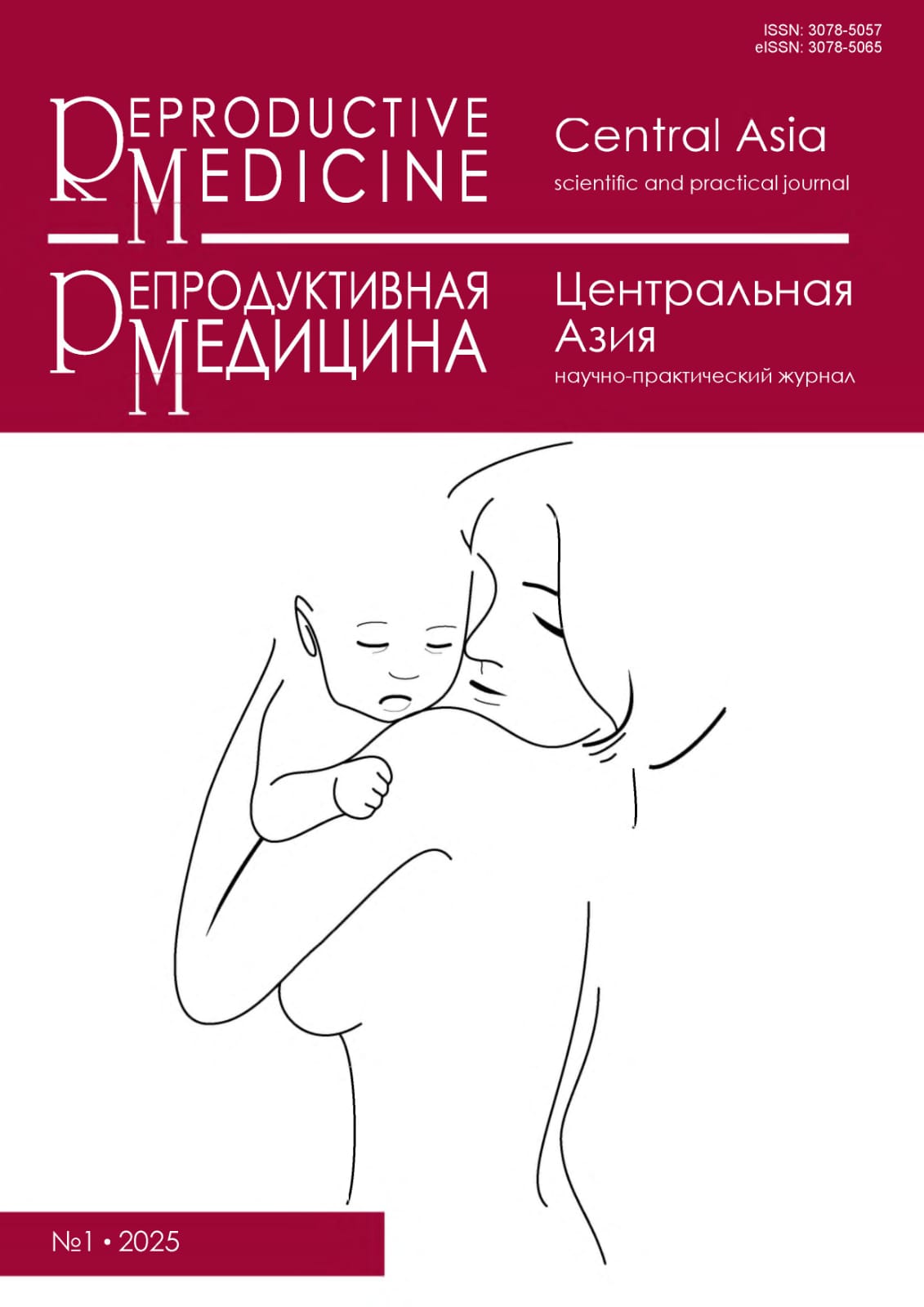Клинические перспективы применения искусственного интеллекта в урогинекологии: обзор литературы
DOI:
https://doi.org/10.37800/RM.1.2025.465Ключевые слова:
искусственный интеллект, глубокое обучение, обработка естественного языка, урогинекология, гинекологияАннотация
Актуальность: За последние десятилетия применение искусственного интеллекта (ИИ) в медицине значительно расширилось, охватывая практически все медицинские дисциплины. Технологии ИИ находят применение в различных областях акушерства и гинекологии, включая общее акушерство, гинекологическую хирургию, пренатальное ультразвуковое исследование и вспомогательные репродуктивные технологии и т.д. ИИ является одной из наиболее активно развивающихся технологий в медицине, особенно в специальностях, где визуализация играет ключевую роль. В гинекологии ИИ уже продемонстрировал значительный потенциал в нескольких направлениях, в частности в онкологии, где исследования показали многообещающие результаты. Однако в урогинекологии, несмотря на широкое использование методов визуальной диагностики и тестов для оценки состояния тазового дна у женщин, проведено значительно меньше исследований, посвященных применению ИИ.
Цель исследования – анализ текущего состояния ИИ в акушерстве и гинекологии, оценка достижений машинного обучения, способствующих развитию данной области, выявление существующих ограничений и определение перспектив дальнейшего применения ИИ.
Материалы и методы: Проведен поиск научных публикаций в поисковых системах PubMed, Scopus, Google Scholar, e-Library на английском, казахском и русском языках по ключевым словам и медицинским тематическим заголовкам среди материалов, опубликованных с 1 января 2020 года по 10 февраля 2025 года. В обзор было включено 48 статей.
Результаты: В данном обзоре анализируется трансформирующее влияние технологий ИИ на диагностику, лечение и ведение урогинекологических заболеваний. Рассматриваются ключевые достижения в области визуализационных методов, предиктивной аналитики и персонализированной медицины, основанных на ИИ, с акцентом на их роль в повышении точности диагностики, улучшении дородового ухода и оптимизации урогинекологических вмешательств.
Заключение: Обзор литературы подчеркивает значительный потенциал ИИ в повышении стандартов медицинской помощи в урогинекологии, что может способствовать улучшению клинических исходов и укреплению репродуктивного здоровья женщин. Представленный анализ текущего применения ИИ и его будущих перспектив демонстрирует необходимость дальнейших исследований и разработки стратегий для безопасного и эффективного внедрения этих технологий в клиническую практику.
Библиографические ссылки
Brandão M, Mendes F, Martins M, Cardoso P, Macedo G, Mascarenhas T, Mascarenhas Saraiva M. Revolutionizing Women’s Health: A Comprehensive Review of Artificial Intelligence Advancements in Gynecology. J Clin Med. 2024;13. https://doi.org/10.3390/jcm13041061
Mota J, Almeida MJ, Mendes F, Martins M, Ribeiro T, Afonso J, Cardoso P, Cardoso H, Andrade P, Ferreira J, Mascarenhas M., Macedo G. From Data to Insights: How Is AI Revolutionizing Small-Bowel Endoscopy? Diagnostics. 2024;14(3):291. https://doi.org/10.3390/diagnostics14030291
Amisha, Malik P, Pathania M, Rathaur V. Overview of artificial intelligence in medicine. J Family Med Prim Care. 2019;8(7):2328-2331.
https://doi.org/10.4103/jfmpc.jfmpc_440_19
Basu K, Sinha R, Ong A, Basu T. Artificial intelligence: How is it changing medical sciences and its future? Indian J Dermatol. 2020;65(5):365-370.
https://doi.org/10.4103/ijd.IJD_421_20
Iftikhar PM, Kuijpers M V, Khayyat A, Iftikhar A, DeGouvia De Sa M. Artificial Intelligence: A New Paradigm in Obstetrics and Gynecology Research and Clinical Practice. Cureus. 2020;12(2):e7124.
https://doi.org/10.7759/cureus.7124
Rajkomar A, Dean J, Kohane I. Machine Learning in Medicine. New Engl J Med. 2019;380:14.
https://doi.org/10.1056/nejmra1814259
Zimmer-Stelmach A, Zak J, Pawlosek A, Rosner-Tenerowicz A, Budny-Winska J, Pomorski M, Fuchs T, Zimmer M. The Application of Artificial Intelligence-Assisted Colposcopy in a Tertiary Care Hospital within a Cervical Pathology Diagnostic Unit. Diagnostics. 2022;12(1):106.
https://doi.org/10.3390/diagnostics12010106
Turing AM. Computing Machinery and Intelligence. The MIT Press eBooks: 1990. https://doi.org/10.7551/mitpress/6928.003.0012.
McCarthy J, Minsky ML, Rochester N, Shannon CE. A Proposal for the Dartmouth Summer Research Project on Artificial Intelligence, August 31, 1955. AI Magazine. 2006;27(4):12.
https://doi.org/10.1609/aimag.v27i4.1904
Jiang F, Jiang Y, Zhi H, Dong Y, Li H, Ma S, Wang Y, Dong Q, Shen H, Wang Y. Artificial intelligence in healthcare: Past, present and future. Stroke Vasc Neurol. 2017;2.
https://doi.org/10.1136/svn-2017-000101
Jayatilake SMDAC, Ganegoda GU. Involvement of Machine Learning Tools in Healthcare Decision Making. J Healthc Eng. 2021;2021(1):1-20.
https://doi.org/10.1155/2021/6679512
Jordan MI, Mitchell TM. Machine learning: Trends, perspectives, and prospects. Science. 2015;349(6245):255-260.
https://doi.org/10.1126/science.aaa8415
Saw SN, Ng KH. Current challenges of implementing artificial intelligence in medical imaging. Physica Med. 2022;100:12-17.
https://doi.org/10.1016/j.ejmp.2022.06.003
Shen YT, Chen L, Yue WW, Xu HX. Artificial intelligence in ultrasound. Eur J Radiol. 2021;139:109717.
https://doi.org/10.1016/j.ejrad.2021.109717
Yoon I, Gupta N. Pelvic Prolapse Imaging [Internet]. Treasure Island (FL): StatPearls Publishing; 2023. Available from:
https://www.ncbi.nlm.nih.gov/books/NBK551513/
Akkus Z, Cai J, Boonrod A, Zeinoddini A, Weston AD, Philbrick KA, Erickson BJ. A Survey of Deep-Learning Applications in Ultrasound: Artificial Intelligence–Powered Ultrasound for Improving Clinical Workflow. J Am College Radiol. 2019;16(9):138-1328. https://doi.org/10.1016/j.jacr.2019.06.004
Zaharchuk G, Davidzon G. Artificial Intelligence for Optimization and Interpretation of PET/CT and PET/MR Images. Semin Nucl Med. 2021;51(2):134-142.
https://doi.org/10.1053/j.semnuclmed.2020.10.001
Paudyal R, Shah AD, Akin O, Do RKG, Konar AS, Hatzoglou V, Mahmood U, Lee N, Wong RJ, Banerjee S, Shin J, Veeraraghavan H, Shukla-Dave A. Artificial Intelligence in CT and MR Imaging for Oncological Applications. Cancers (Basel).2023;15(9):2573.
https://doi.org/10.3390/cancers15092573
Kurdoğlu M, Khaki A. The Use of Artificial Intelligence in Urogynecology. Intl J Women’s Health Reprod Sci. 2024;12:001-002.
https://doi.org/10.15296/ijwhr.2024.6003
Battineni G, Chintalapudi N, Ricci G, Ruocco C, Amenta F. Exploring the integration of artificial intelligence (AI) and augmented reality (AR) in maritime medicine. Artif Intell Rev. 2024;57:100.
https://doi.org/10.1007/s10462-024-10735-0
Rajesh A, Asaad M. Artificial Intelligence and Machine Learning in Surgery. Am Surg. 2023;89(1):9-10.
https://doi.org/10.1177/00031348221117024
Daykan Y, O’Reilly BA. The role of artificial intelligence in the future of urogynecology. Int Urogynecol J. 2023;34:1663-1666.
https://doi.org/10.1007/s00192-023-05612-3
Seval MM, Varlı B. Current developments in artificial intelligence from obstetrics and gynecology to urogynecology. Front Med (Lausanne). 2023;10:1098205.
https://doi.org/10.3389/fmed.2023.1098205
Nekooeimehr I, Lai-Yuen S, Bao P, Weitzenfeld A, Hart S. Automated contour tracking and trajectory classification of pelvic organs on dynamic MRI. J Med Imaging. 2018;5(1):014008.
https://doi.org/10.1117/1.jmi.5.1.014008
Onal S, Lai-Yuen S, Bao P, Weitzenfeld A, Greene K, Kedar R, Hart S. Assessment of a semiautomated pelvic floor measurement model for evaluating pelvic organ prolapse on MRI. Int Urogynecol J. 2014;25:767-773.
https://doi.org/10.1007/s00192-013-2287-4
Wang X, He D, Feng F, Ashton-Miller JA, DeLancey JOL, Luo J. Multi-label classification of pelvic organ prolapse using stress magnetic resonance imaging with deep learning. Int Urogynecol J. 2022;33:2869-2877.
https://doi.org/10.1007/s00192-021-05064-7
Zhang M, Lin X, Zheng Z, Chen Y, Ren Y, Zhang X. Artificial intelligence models derived from 2D transperineal ultrasound images in the clinical diagnosis of stress urinary incontinence. Int Urogynecol J. 2022;33:1179-1185.
https://doi.org/10.1007/s00192-021-04859-y
Mascarenhas M, Afonso JPL, Ribeiro T, Cardoso P, Mendes F, Martins M, Andrade A, Cardoso H, Ferreira J, Macedo G. S699 Deep Learning and Minimally Invasive Endoscopy – Panendoscopic Detection of Pleomorphic Lesions. Am J Gastroenterol. 2023;118:123-138.
https://doi.org/10.14309/01.ajg.0000952436.94054.86.
Negassi M, Suarez-Ibarrola R, Hein S, Miernik A, Reiterer A. Application of artificial neural networks for automated analysis of cystoscopic images: a review of the current status and future prospects. World J Urol. 2020;38:2349-2358.
https://doi.org/10.1007/s00345-019-03059-0
Aramendía-Vidaurreta V, Cabeza R, Villanueva A, Navallas J, Alcázar JL. Ultrasound Image Discrimination between Benign and Malignant Adnexal Masses Based on a Neural Network Approach. Ultrasound Med Biol. 2016;42(3):742-752.
https://doi.org/10.1016/j.ultrasmedbio.2015.11.014
Moawad G, Tyan P, Louie M. Artificial intelligence and augmented reality in gynecology. Curr Opin Obstet Gynecol. 2019;31(5):345-348.
https://doi.org/10.1097/GCO.0000000000000559
Taylor RA, Moore CL, Cheung KH, Brandt C. Predicting urinary tract infections in the emergency department with machine learning. PLoS One. 2018;13(3):e0194085.
https://doi.org/10.1371/journal.pone.0194085
Goździkiewicz N, Zwolińska D, Polak-Jonkisz D. The Use of Artificial Intelligence Algorithms in the Diagnosis of Urinary Tract Infections—A Literature Review. J Clin Med. 2022;11.
https://doi.org/10.3390/jcm11102734
Cherukuri S, Jajoo S, Dewani D. The International Ovarian Tumor Analysis-Assessment of Different Neoplasias in the Adnexa (IOTA-ADNEX) Model Assessment for Risk of Ovarian Malignancy in Adnexal Masses. Cureus. 2022;14(11):e31194.
https://doi.org/10.7759/cureus.31194
Jones OT, Calanzani N, Saji S, Duffy SW, Emery J, Hamilton W, Singh H, de Wit NJ, Walter FM. Artificial intelligence techniques that may be applied to primary care data to facilitate earlier diagnosis of cancer: Systematic review. J Med Internet Res. 2021;23(3).
Bentaleb J, Larouche M. Innovative use of artificial intelligence in urogynecology. Int Urogynecol J. 2020;31:1287-1288.
https://doi.org/10.1007/s00192-020-04243-2
Zattoni F, Carletti F, Randazzo G, Tuminello A, Betto G, Novara G, Dal Moro F. Potential Applications of New Headsets for Virtual and Augmented Reality in Urology. Eur Urol Focus. 2024;10(4):594-598.
https://doi.org/10.1016/j.euf.2023.12.003
Baessler K, Bortolini M. “The role of artificial intelligence in the future of urogynecology” by Yair Daykan, Barry A. O’Reilly. Int Urogynecol J. 2023;34:1667. https://doi.org/10.1007/s00192-023-05624-z
Polat G, Arslan HK. Artificial Intelligence in Clinical and Surgical Gynecology. İstanbul Gelişim Univ J Health Sci. 2024;21:1232-1241.
https://doi.org/10.38079/igusabder.1291375
Mascagni P, Alapatt D, Sestini L, Altieri MS, Madani A, Watanabe Y, Alseidi A, Redan JA, Alfieri S, Costmagna G, Boškoski I, Padoy N, Hashimoto DA. Computer vision in surgery: from potential to clinical value. NPJ Digit Med. 2022;5:163.
https://doi.org/10.1038/s41746-022-00707-5
Guni A, Varma P, Zhang J, Fehervari M, Ashrafian H. Artificial Intelligence in Surgery: The Future is Now. Eur Surg Res. 2024;65(1):22-39.
https://doi.org/10.1159/000536393
Kitaguchi D, Watanabe Y, Madani A, Hashimoto DA, Meireles OR, Takeshita N, Mori K, Ito M; Computer Vision in Surgery International Collaborative. Artificial Intelligence for Computer Vision in Surgery: A Call for Developing Reporting Guidelines. Ann Surg. 2022;275(4):e609-e611.
https://doi.org/10.1097/SLA.0000000000005319
Eckhoff JA, Fuchs HF, Meireles OR. Application of artificial intelligence in oncologic surgery of the upper gastrointestinal tract. Onkologie. 2023;29:515-521.
https://doi.org/10.1007/s00761-023-01318-9
Serban N, Kupas D, Hajdu A, Török P, Harangi B. Distinguishing the Uterine Artery, the Ureter, and Nerves in Laparoscopic Surgical Images Using Ensembles of Binary Semantic Segmentation Networks. Sensors. 2024; 24(9):2926.
https://doi.org/10.3390/s24092926
Narihiro S, Kitaguchi D, Hasegawa H, Takeshita N, Ito M. Deep Learning-Based Real-Time Ureter Identification in Laparoscopic Colorectal Surgery. Dis Colon Rectum. 2024;67(10):1596-1599.
https://doi:10.1097/DCR.0000000000003335
Kitaguchi D, Takeshita N, Hasegawa H, Ito M. Artificial intelligence-based computer vision in surgery: Recent advances and future perspectives. Ann Gastroenterol Surg. 2021;6(1):29-36.
https://doi:10.1002/ags3.12513
Yu F, Song E, Liu H, Zhu J, Hung CC. Laparoscopic Image-Guided System Based on Multispectral Imaging for the Ureter Detection. IEEE Access 2019;7:3800-3809. https://doi.org/10.1109/ACCESS.2018.2889138.
Sheyn D, Ju M, Zhang S, Anyaeche C, Hijaz A, Mangel J, Sangeeta M, Britt C, El-Nashar S, Soumya R. Development and Validation of a Machine Learning Algorithm for Predicting Response to Anticholinergic Medications for Overactive Bladder Syndrome. Obstet Gynecol. 2019;134(5):946-957.
Загрузки
Опубликован
Как цитировать
Выпуск
Раздел
Лицензия
Copyright (c) 2025 Права на принятую к публикации рукопись передаются Издателю журнала. При перепечатке всего материала или его части автор обязан сослаться на первичную публикацию в данном журнале.

Это произведение доступно по лицензии Creative Commons «Attribution-NonCommercial-NoDerivatives» («Атрибуция — Некоммерческое использование — Без производных произведений») 4.0 Всемирная.
Публикуемые в этом журнале статьи размещены под лицензией CC BY-NC-ND 4.0 (Creative Commons Attribution — Non Commercial — No Derivatives 4.0 International), которая предусматривает только их некоммерческое использование. В соответствии с этой лицензией пользователи имеют право копировать и распространять материалы, охраняемые авторским правом, но им не разрешается изменять или использовать их в коммерческих целях. Полная информация о лицензировании доступна по адресу https://creativecommons.org/licenses/by-nc-nd/4.0/.





